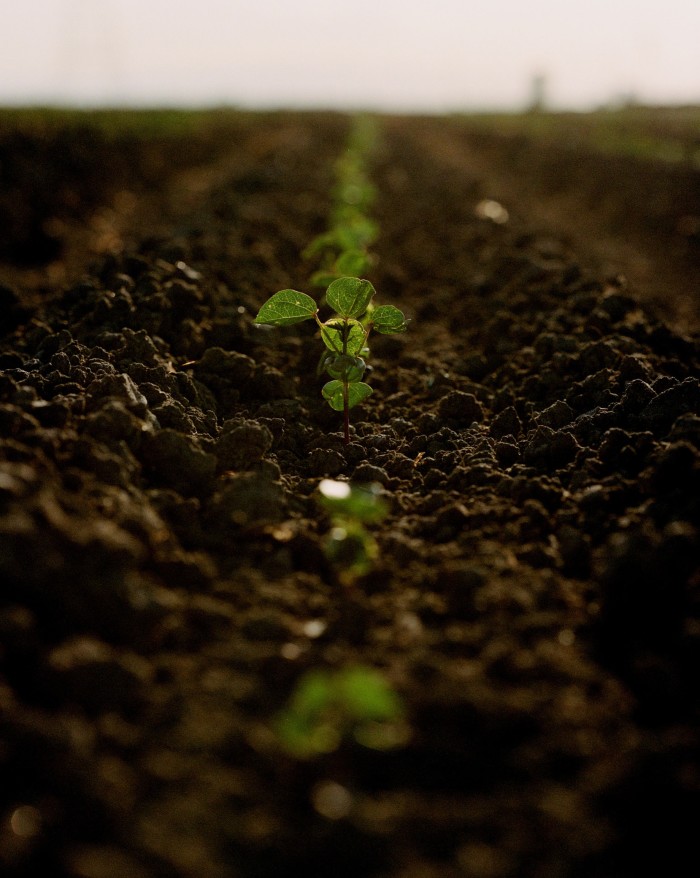How Citizens of Humanity cottoned on to green jeans

Simply sign up to the Fashion myFT Digest -- delivered directly to your inbox.
When Amy Williams, CEO of the LA-based Citizens of Humanity fashion group, watched the 2020 Netflix documentary Kiss the Ground, about restoring the health of the soil to help address climate change, she was kickstarted to “actually start doing things that make an impact”.
In autumn 2021, Williams’ team started the process of transforming the cotton production on the 11 farms in the US and three in Turkey that supply cotton for the group’s three premium brands – Citizens of Humanity, Agolde and Goldsign – into a regenerative process. This meant a return to farming methods that reduced chemical fertilisers and pesticides, reduced tilling, and rotated crops, all to improve soil health and biodiversity.

After two harvests, yielding more than 1.4mn kg of cotton, the group is integrating regenerative cotton into its entire production, including the Citizens of Humanity horseshoe jean, an early-2000s-inspired Rosie miniskirt and straight-legged mid-wash Curtis jeans in the Agolde men’s collection. Canadian supermodel Shalom Harlow, keen to support the initiative, fronts the campaign. “It’s been a bit like giving birth,” says Williams, a mother of twins, of the scheme. “You put in all this work and you’re just hopeful about the outcome, but you don’t know what it will be.”

She was right to be concerned: the farmers faced challenges ranging from two hailstorms in Texas to droughts in Oklahoma, floods in Mississippi, water shortages in Turkey and a plague of grasshoppers that the west Texan owners’ pre-schooler attempted to fight off with a stick.
Regenerative farming is better known in food production but is slowly catching on in fashion. Outdoor brand Patagonia has invested in a programme in India, where Levi Strauss & Co also partners with regenerative schemes. In 2021, the luxury group Kering launched the Regenerative Fund for Nature with the aim of transforming 1mn hectares into regenerative agricultural spaces by 2026, with Spanish multinational Inditex, which owns Zara, joining last year. Citizens of Humanity is the first apparel group to work with US cotton growers.


The practice boasts many benefits, from improved soil health, decreased soil erosion and increased air and water quality, but its biggest assertion is that regenerated soil is more effective at capturing large amounts of CO2 from the atmosphere. The Rodale Institute, a US-based nonprofit, reported in a white paper that the enormous amount of recent data on soil carbon sequestration shows that regenerative agriculture has the potential to “draw down more than 100 per cent of annual CO2 emissions”.
The measurable effects of regenerative agriculture vary by farm, region, country and climate, but Jessica Chiartas, a soil biogeochemist and executive director of Soil Life, points out that even in “hot, dry California, where improvements to things like soil carbon and microbial biomass can be very challenging to achieve, we have seen impressive changes”. She has preliminary data from more than 30 sites across California “showing average increases in soil carbon of 20 per cent, over a three-year period of implementing regenerative management”.


Chiartas has been advising and auditing Citizens of Humanity’s regenerative programme for the past year, helping develop similar monitoring targets for its farms; the group’s US farmers have this month been awarded the data-driven standard accreditation “Integrity Grown” by the body Advancing Eco Agriculture (AEA) for its work.
The endeavour has come at a cost to the company of “an extra $1.5mn above what we’d normally pay for the cotton”, according to Williams. The group paid the farmers for any costs they incurred switching to regenerative methods, from training to equipment, as well as guaranteeing a higher price for their crops and a commitment to buy over the following years. “We had to make sure the farmers believed we were there to support them in the long term,” she says.

Regenerative farming is not the silver bullet to the fashion industry’s seismic environmental impact, nor does it yet fulfil Citizen’s demands (the harvest currently yields about 80 per cent of its total cotton needs, but the group is able to make up the shortfall with cotton already in the warehouse). But Williams, who has been talking to other premium brands about her learnings, believes it’s a big step forward. “I worry about the next generation. I’ve got a responsibility to take any positive steps that could actually be part of the solution for climate change,” she says, “and this is an exciting one.”

Comments